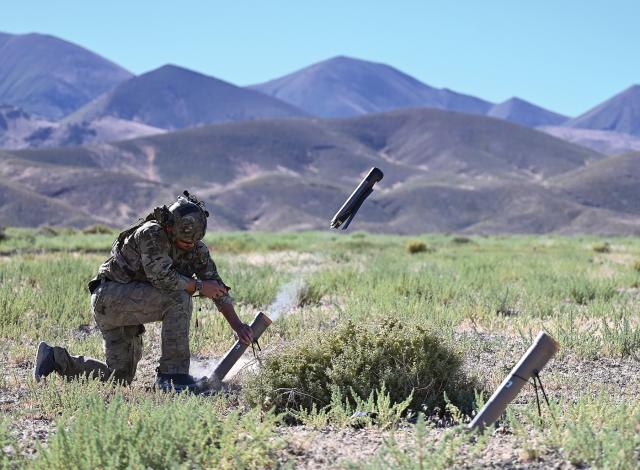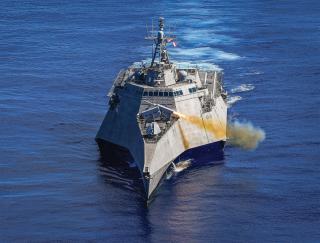Classmate and prolific writer Sam Tangredi (17th Co.)’s article Replicate Ordnance, Not Cheap Drones wins first prize in the US Naval Institute Proceedings General Prize Essay Contest. Sam previously won second prize in this contest in 2003 and third prize in 2023.
Replicate Ordnance, Not Cheap Drones
General Prize Essay Contest—First Prize
Sponsored by Andrew and Barbara Taylor
Even a “successful” Replicator Initiative will not produce the right tools to offset China’s growing military. What the Pentagon needs is more weapons. Lots of them.
By Captain Sam Tangredi, U.S. Navy (Retired)
March 2024
“With Replicator, we’re beginning with all-domain, attritable autonomy, or ADA2, to help us overcome the PRC’s advantage in mass: more ships, more missiles, more forces.”
—Deputy Secretary of Defense Kathleen Hicks, 6 September 2023
Deputy Secretary Kathleen Hicks has been given an impossible task: convincing the Department of Defense (DoD), Congress, the American people, and the nation’s allies and adversaries that large numbers of cheap, autonomous drones are the answer to the U.S. military’s shortfalls.
The Replicator Initiative was to be achieved by September 2025 with no additional money added to the defense budget.1 Hicks described the key to the project as “American ingenuity: our ability to innovate, change the game and, in the military sphere, to imagine, create and master the future character of warfare.”2 The objective is to offset China’s military mass.3
It is important to point out the incongruity of the premise behind the Replicator Initiative—that some thus-far-unattained advancements in miniaturized technology, procured at low cost, will create inexpensive, effective, and autonomous systems that can deter or defeat an opponent that is building a large, lethal, high-tech military force.
To make matters worse, that opponent is the very source of many of the cheap components needed for low-cost “replication.” Truly, the premise of Replicator is hope, not strategy.
Announcing the Replicator Initiative

Secretary Hicks announced the Replicator Initiative in August 2023 at a Washington conference of the National Defense Industrial Association (NDIA). Its stated goal was to offset an expanding People’s Liberation Army (PLA) by fielding “attritable, autonomous systems at a scale of multiple thousands [and] in multiple domains within the next 18-to-24 months.” However, a key word in that statement is “systems,” not weapons. As one source writes, “Notably, Hicks also clarified that [the program] is ‘not synonymous’ with weapons systems.”4
An additional problem the initiative is designed to overcome is the “valley of death” in DoD acquisition—the difficulty in moving a research and development (R&D) effort across all the administrative, bureaucratic, and regulatory hurdles to become a fully funded program of record. Small companies often cannot survive the processes and waiting required by the traditional DoD acquisition system. Presumably, Replicator can minimize process difficulties and time delays by using alternative funding methods to produce systems cheaply and quickly, allowing small, innovative firms entry into the defense market.5 Awkwardly, this initiative seeks solutions to acquisition problems of the U.S. government’s own making. Replicator is, from that perspective, just a work-around.
As a means of branding the initiative, Hicks introduced the term “all-domain, attritable autonomy” or ADA2, as a counter to “antiaccess/area-denial” (A2/AD), which is used to describe Chinese systems designed to keep the United States and other nations from interfering in a China-Taiwan fight.6 The types of cheap drones envisioned by Replicator would be a good addition to counter Chinese A2/AD capabilities, but they would not be sufficient to allow U.S. forces to deter or defeat a Chinese military campaign against Taiwan.
The Problem
The basic concept of the Replicator Initiative is not the problem. If acquired cheaply, a large number of various small uncrewed vehicles (UVs) would be a reasonable tool to add to the U.S. military’s tactical inventory. In certain scenarios, small drones—particularly UAVs at low altitude—can provide advantages. If “attritable” or expendable, they do not need to be defended. They can close with the enemy—particularly in land combat—to increase standoff range for troops engaged on the ground.
Indeed, hand-launched drones, such as the RQ-11 Raven, were used by the Army and Marine Corps on the company level in Iraq for close reconnaissance missions. Earlier, relatively small deck- or catapult-launched drones were used in combat, notably the Navy’s RQ-2 Pioneer to which Iraqi soldiers on Failaka Island surrendered during Operation Desert Storm in 1991. But such UAVs were mostly sensors, not weapons.
The most significant problems for the Replicator program are: hype, mission limitations, and the drain of resources and attention from more important needs.
The first problem is that the highly-publicized launch of the program created an expectation that it cannot fulfill—the ability to counter China “with [small] mass produced autonomous systems” of limited lethality. Some media outlets have portrayed the Replicator Initiative as a “game changer”—a cringe-worthy cliché that only serves to burden defense debates.7 This constitutes considerable hype, since the small, autonomous systems thus far described—like their predecessors—are mainly intelligence, surveillance, and reconnaissance (ISR) platforms that complement existing long-range ISR capabilities. Indeed, the uncrewed surface vessels the U.S. Navy’s Task Force 59 has tested in the Persian Gulf are composed primarily of sensors that replace existing capabilities to perform maritime domain awareness missions more cheaply.8 They are not, however, weapons, and they are range and sea-state limited.
This leads to a second problem: the impression that small, cheap autonomous platforms can carry out missions at the ranges expected in a conflict with China. Popular interest in drones exploded following their widespread use in the war in Ukraine. Yet, the vast distances of the western Pacific—along with the environmental conditions—appear to be an insurmountable challenge for small, cheap UVs. The average attack range for the much touted “kamikaze drones” used in combat missions by Ukrainian forces has been seven miles, not 700 or 1,700.9

A Breaking Defense article supporting and urging additional funding for the Replicator program nevertheless admits:
The classes of drones relevant in the Indo-Pacific are fundamentally different than those relevant to Ukraine. . . . The closest the United States will likely be operating from is 100–200 plus nautical miles away, with the nearest sovereign U.S. territory some 1,500 nautical miles away. . . . That means small UAVs that can be produced in staggering numbers—the kind of capability so helpful in Ukraine . . . are, minimally, going to be brought to the fight by a larger platform . . . . More likely, drones relevant to U.S. operations in the Indo-Pacific . . . will have to be larger than those in Europe, and those systems are currently nowhere close to the kinds of production levels [or costs] hinted at.10
The third problem is that Replicator fosters the belief than a large inventory of small drones satisfies defense requirements when facing the pacing threat.
Therein lies the most insidious danger: Promoting a “replicator strategy” perpetuates the belief that there is some miraculous emerging technology or concept that can overturn the size advantage of an adversary force equally adept with technology. That has never been true.
Where Replicator Can Make a Difference

Despite range and payload limitations, there are two missions in which the Replicator Initiative could enhance deterrence or lead to victory in a Taiwan Strait scenario. First is the use of massive swarms of kamikaze drones to defend the beaches of Taiwan against Chinese amphibious landings. As in the kamikaze attacks of World War II, numbers matter. An inventory of cheap air and sea drones could saturate the landing zones with loitering ordnance. If People’s Liberation Army (PLA) defensive weapons cannot cycle fast enough to target significant numbers of the swarming UVs, considerable damage could be inflicted on the invading force.
Replicator drones would form another barrier in a defense-in-depth porcupine strategy, striking enemy platforms at ranges greater than artillery and prior to the mine barriers emplaced in the surf zone. At the same time, swarms of kamikaze UAVs could impede PLA Air Force low-altitude close-air support of the landing force. Small UAVs could create a lot of mechanical bird strikes for Chinese pilots.
Of course, such employment would be a last-ditch defense, similar in manner to the Phalanx close-in weapons system’s “wall of steel.”11 If the invasion force reached the distance at which current versions of cheap drones can operate, the battle would not be going well for Taiwan. Nevertheless, the Replicator Initiative could increase the lethality of Taiwan defenses when combined with artillery, rockets, naval and land mines, and attack aviation. A U.S.-produced inventory of Replicator UVs might be the most cost-effective international assistance provided to Taiwan. The United States could build them and give them to Taiwan. On the other hand, Taiwanese industries likely could build them as fast and at scale.
A second mission that could be enhanced by flocks of Replicator drones is long-range, line-of-sight, ultra-high frequency (UHF) communication and data transmission. Satellite UHF is now the mainstay of U.S. joint force communications. But as retired Navy Vice Admiral Brian Brown pointed out, in the War of 2026 scenario, China would target satellite communication networks.12 Navy commanders have stressed that if satellite UHF is unavailable in combat, alternative means of relaying data will be critical. The existing inventory of U.S. Navy E-2D Hawkeye aircraft provide some of those capabilities, but not enough. Expensive high-altitude UAVs may be part of the answer, but large quantities of low-altitude communication relay UAVs could provide the best means of connecting distributed forces in the absence of satellite communications.
The Replicator Initiative might eventually prove a wise investment and make a significant difference. If current trends continue, ADA2 might become an element of U.S. A2/AD. If or when the PLA Navy overtakes the U.S. Navy, China might outgrow its defensive stance and opt for a power projection strategy supported by bases outside the second island chain (such as in the Solomon Islands). If so, Replicator drones might be key to the defense of Guam or Hawaii.
Ukraine and Drone Fantasies

An impetus for the Replicator Initiative has been the extensive public discussion of the use of cheap drones used by both sides in the war in Ukraine. UAVs have been used in abundance in that war for C4ISR. As a means of acquiring information—particularly where no other means is available—they have proven their worth. In particular, small drones are useful in gathering tactical information for immediate use in a confined battlespace. Larger UAVs—such as the U.S.-made MQ-9 Reaper, the Turkish Bayraktar BT-2 (used by Ukrainian forces), and the Iranian Shahed (employed by the Russian military)—are more capable and have longer ranges and payloads but also are more expensive and fewer in number.13
Admittedly, cheap drones have been used to tactical advantage by both sides in the war in Ukraine, generating significant media interest and commentary. Nevertheless, they have not had strategic effect. As far as can be determined from open-source reporting, small, armed drones have not won any battles. They have functioned as loitering munitions—slow smart bombs—but they are just one tool in a combined-arms fight. They have provided advantages in some missions, such as waiting aloft to dive directly or drop small munitions on the tops of tank turrets, where armor is usually weakest. They also have been used to disable military logistics vehicles. However, media have overhyped the effects of explosive-laden UAVs.
Cheap drones are useful in the same way as other weapons that wait—such as land and naval mines and IEDs. They can shape the battlefield. They have proven particularly good at destroying unprotected infrastructure and killing civilians and unprotected or unprepared troops. But, they are neither “game changers” nor war winners. To expect a program of thousands of cheap drones to defeat a technologically sophisticated opponent with a large inventory of conventional ordnance is a fantasy.
Franz-Stefan Gady, a senior fellow at the Institute for Strategic Studies, sums up the situation: “The idea that there is a shortcut to victory raises expectations for a quick end to the carnage. . . . After more than 18 months of grinding, attritional war, it should be obvious that there are no miracle weapons and that there are no alternatives to slowly and methodically reducing Russian forces in Ukraine.”14
For combat drones—in the air, on land, or on or under the sea—effectiveness is a function of explosive power to size and cost. To duplicate the explosive power of a ballistic missile requires a drone that is large and expensive—perhaps more expensive than some ballistic missiles. That is one of the reasons Hamas primarily relies on missiles for strikes on Israel, rather than drones.
On 1 February 2024, a swarm of Ukrainian Magura V5 maritime drones attacked and destroyed a Russian Project 12411 missile corvette, the Ivanovets, off the coast of Crimea.15 While a significant tactical win for uncrewed surface vessels, the Magura V5 is not a small, cheap drone. With a length of 5.5 meters, a payload of 320 kg, and a price tag of several hundred thousand dollars, these boats are more akin to the cruise missiles that sank the Russian Navy cruiser Moskva and destroyed other ships in maintenance in Sevastopol—they are weapon systems with significant explosive power.
A Better Approach: “Ordnator”
As useful as flocks of drones may bein specific tactical situations and as a means of extending low-altitude C4ISR, they are insufficient to win wars. One can envision swarms of surface drones used to breach simple defenses. However, multiple layers of defensive weapons can defeat them. Surface-to-air missiles, high-powered lasers and microwave systems, antiaircraft guns, jammers, and decoys, flares, and chaff can all impede or defeat incoming drones.
A more significant initiative would be described as “Ordnator”—the rapid production of weapons that could create massive damage on any force attempting to cross the Taiwan Strait or South China Sea. An Ordnator Initiative would put weapons before platforms.
Some of the necessary U.S. weapons, such as Long-Range Antiship Missiles (LRASMs), are already in production, but there is insufficient inventory to defeat or even deter the PLA.16 Others—such as sophisticated sea mines—require additional R&D to modernize with the latest digital capabilities. An inventory of 10,000 sea mines capable of sinking or inflicting heavy damage on PLA Navy (PLAN) ships and landing craft would go further to deterring an invasion of Taiwan than swarms of less-lethal unmanned vehicles. The ability to deliver large quantities of such mines, stealthily, in various water depths, in the Taiwan Strait and the littorals around Taiwan and China, would sow doubt in the minds of China’s leaders that they could accomplish their objectives by force. Autonomous/AI-driven systems, such as the Orca Extra-Large Undersea Unmanned Vehicle, could lay mines in times of tension or conflict with no risk to human sailors. While it might seem that Orca would fall under the Replicator Initiative, it does not because Orca is already a program of record. But as retired Admiral Sandy Winnefeld pointed out in his recent American Sea Power Project article, “Mine Warfare Could Be Key,” “It is doubtful either of these systems [Orca or the Clandestine Delivered Mine it is intended to carry] will be fielded in an operationally effective quantity by [2026].”17
To fund an ordnance buildup within the current defense budget—the economy ascribed to Replicator—would require DoD to shift acquisition priorities immediately. Programs that could be reduced or delayed include: exquisite C4ISR systems (such as JADC2) that would be the first casualties in a war characterized by high levels of electromagnetic, cyber, and space warfare; and manned aircraft that lack the range or survivability to operate within China’s weapons engagement zone.
Replicating for Defeat?
The Replicator Initiative is focused on the wrong goals, lured by the perception from the war in Ukraine that vast numbers of small, cheap uncrewed systems can make a strategic difference. They cannot—especially in a war against China in the western Pacific. A collection of sensing drones cannot overcome the expanding mass, lethality, and reach of the PLAN, Air Force, and Rocket Forces. Unless Replicator drones pack more firepower and range than existing systems, the ultimate objective of ensuring China’s leaders wake up every day, consider the risk of aggression, and conclude, “Today is not the day” will not be achieved.18
Instead of “imag[ining] flocks of ADA2 systems flying at all sorts of altitudes, doing a range of missions, building on what we’ve seen in Ukraine,” the Department of Defense needs to build an inventory of thousands of LRASMs, antiship mines, torpedoes, and other weapons capable of sinking each and every Chinese vessel attempting to cross the Taiwan Strait.19
1. Noah Robertson, “Replicator Drone Program Needs No New Money, Hicks Says,” Defense News, 6 September 2023.
2. Jim Garamone, “Hicks Discusses Replicator Initiative,” Department of Defense (website), 7 September 2023.
3. Patrick Tucker, “’Hellscape’: DoD Launches Massive Drone Swarm Program to Counter China,” Defense One, 28 August 2023.
4. Brandi Vincent, “Hicks Shares New Details on DoD’s Vision for Replicator Autonomous Systems, but Questions Linger,” DefenseScoop, 6 September 2023.
5. There are precedents. As late as the 1970s, small numbers of drones, auxiliary systems, and unique parts were produced in relatively small machine shops.
6. “All-domain” originated as a naval term whose use stretches back at least to the tenure of CNO Admiral Jonathan Greenert (2011–2015) and is preferred to “multi-domain.”
7. Tech Desk, “Hicks Reveals Game-Changing Replicator Initiative: U.S. Defense Department’s Cutting-Edge Breakthrough!” Compsmag, 7 September 2023.
8. Brandi Vincent, “Navy’s Task Force 59 Reaches Full Operational Capability as It Works to Build a ‘Digital Ocean’ of Connected Assets,” DefenseScoop, 10 January 2023.
9. “Kamikaze drones must get very close to be effective . . . the average range is seven miles from the operator. Drone operators target the drivers of vehicles.” See, “How Ukrainian DIY Drones Are Taking Out Russian Tanks,” Wall Street Journal video, 27 July 2023.
10. Andrew Metrick, “For Replicator to Work, the Pentagon Needs to Directly Help with Production,” Breaking Defense, 7 September 2023.
11. Secretary Hicks mentions Phalanx CIWS (as well as AEGIS) in her listing of “integrating autonomy into weapons systems.” See Noah Robertson, “Replicator Drone Program Needs No New Money, Hicks Says.”
12. VADM Brian Brown, USN (Ret.), “The Challenge of Joint Space Operations,” U.S. Naval Institute Proceedings 150, no. 1 (January 2024).
13. On 14 March 2023, an MQ-9 Reaper UAV was downed by Russian aircraft over the Black Sea. See Amanda Macias, “Russian Jet Collides with, Downs U.S. Drone over Black Sea,” CNBC, 14 March 2023.
14. Franz-Stefan Gady, “Why There Are No Game-Changing Weapons for Ukraine,” Foreign Policy, 14 September 2023.
15. “Ukraine Uses Satellite Guided Naval Drone to Hit and Destroy Russian Missile Corvette, the Ivanovets, in a Modern Warfare First,” Intellinews, 5 February 2024. See also, Magura V5 Wikipedia page for cost information.
16. “The Air Force budget calls for buying just 27 of the missiles in fiscal 2024, with the Navy requesting 91.” See Chris Gordon, “Lockheed Martin Looks to Boost LRASM Production as U.S. Rushes to Buy Antiship Weapons,” Air & Space Forces Magazine, 4 April 2023.
17. ADM James A. Winnefeld, USN (Ret.), “Mine Warfare Could Be Key,” U.S. Naval Institute Proceedings 149, no. 12 (December 2023).
18. Lee Ferran and Jaspreet Gill, “’Replicator’ Reveal: Pentagon Initiative to Counter China with Mass-produced Autonomous Systems,” Breaking Defense, 28 August 2023.
19. Vincent, “Hicks Shares New Details.”
Captain Tangredi is a retired surface warfare officer and the Leidos Chair for the Future of Naval Warfare Studies at the Naval War College in Newport, Rhode Island, and a frequent contributor to Proceedings. He won second prize in this contest in 2003 and third prize in 2023.

